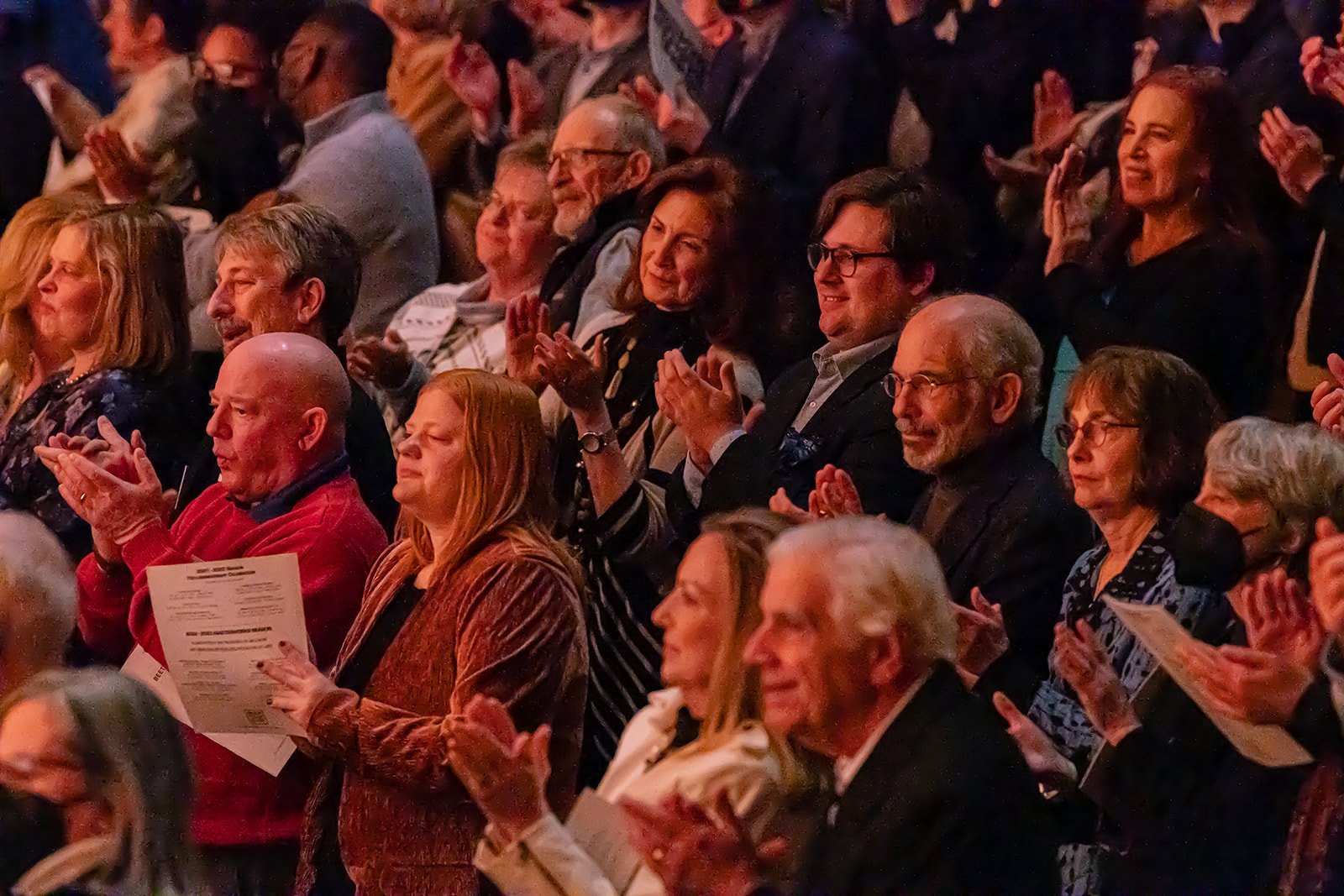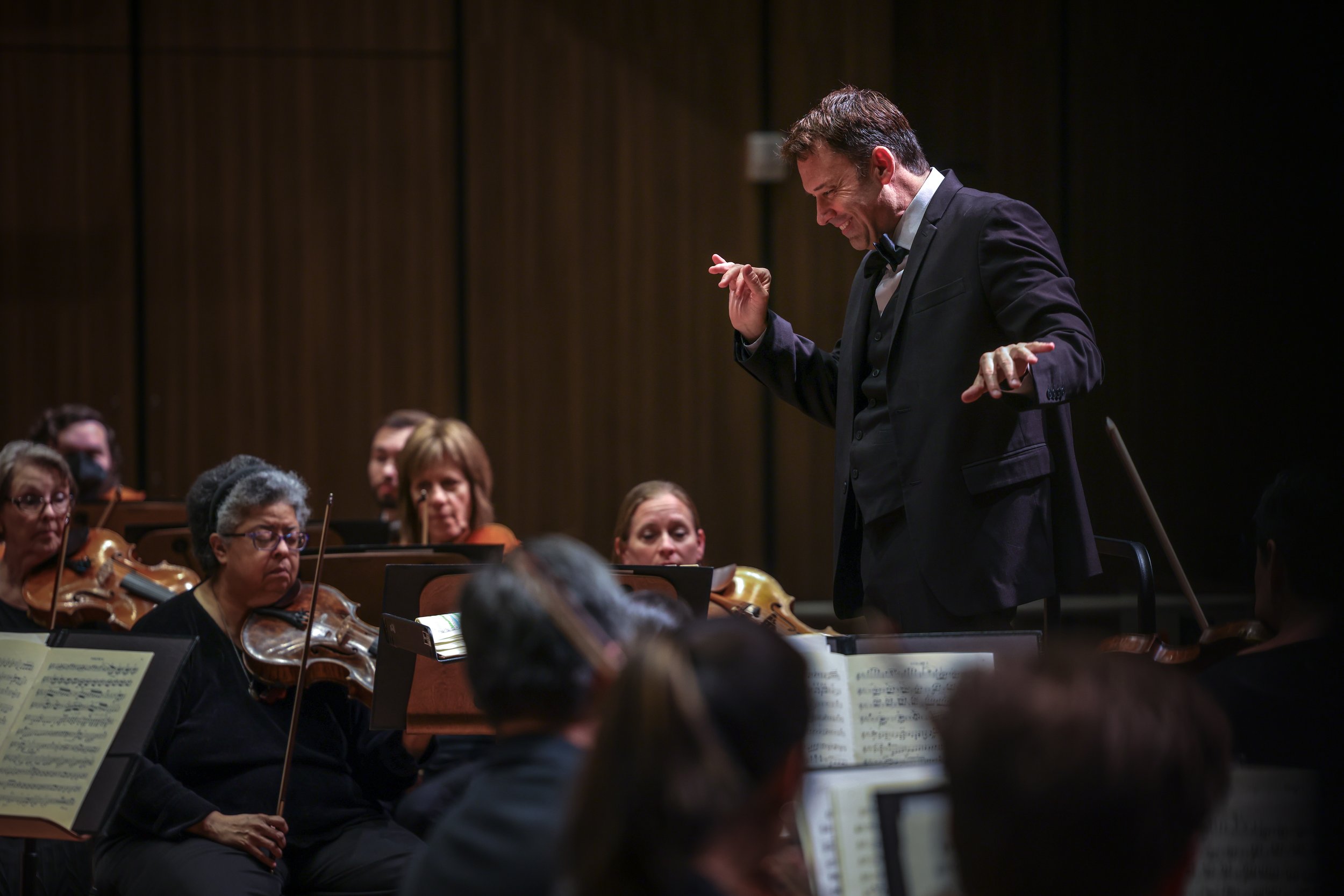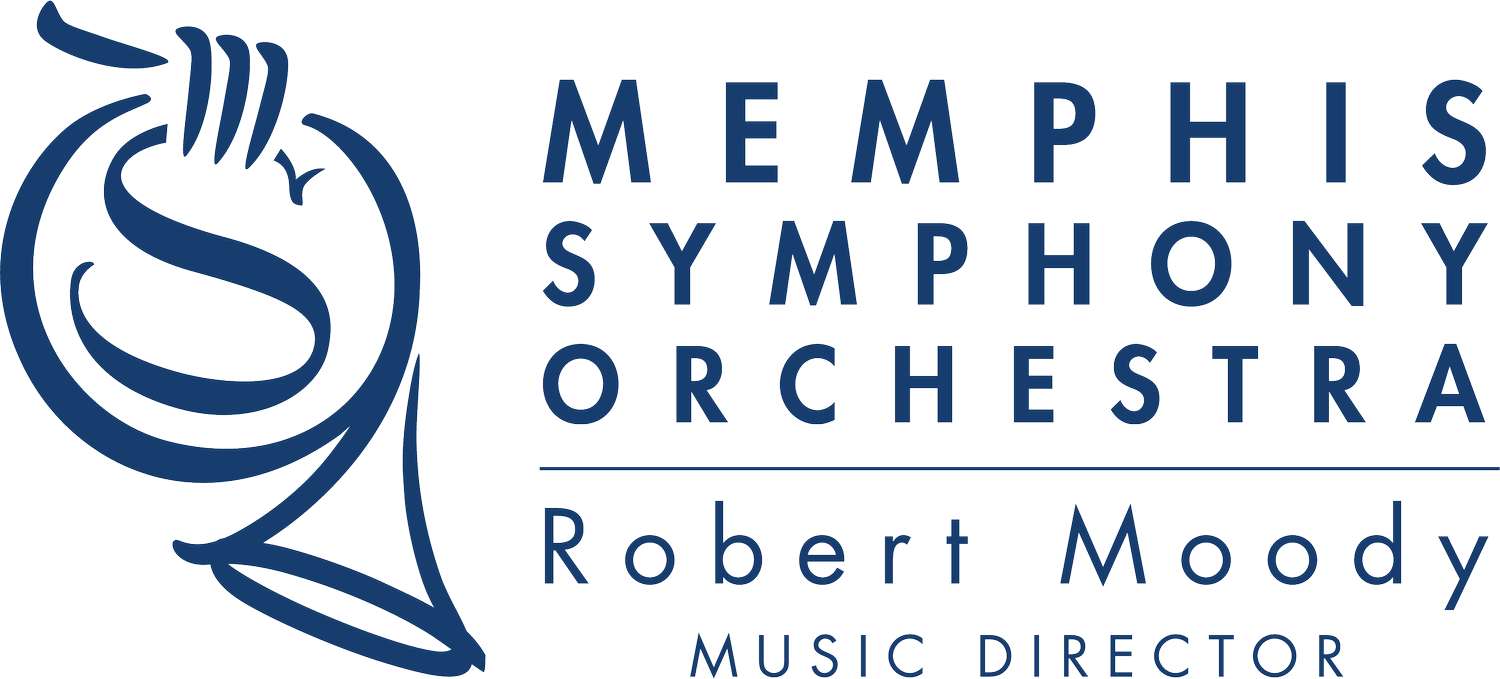
DVOŘÁK NEW WORLD SYMPHONY
Saturday, May 25, 2024 · 7:30pm ·
Cannon Center for the Performing Arts
—————————
Sunday, May 26, 2024 · 2:30pm ·
Scheidt Family Performing Arts Center
PIOTR ILYICH TCHAIKOVSKY
(1840 - 1893)
Overture solonelle, op. 49, “ 1812”
MAURICE RAVEL
(1875 - 1937)
Concerto in G Major for Piano and Orchestra
I. Allegramente
II. Adagio assai
III. Presto
INTERMISSION
ANTONIN DVOŘÁK
(1841 - 1904)
Symphony No. 9 in E minor, op. 95, "From the New World"
I. Adagio - Allegro molto
II. Largo
III. Scherzo: Molto vivace
IV. Allegro con fuoco
Program Notes
by Michelle Pellay-Walker
Masterworks Three (rescheduled from January 2024)
Piotr Ilyich Tchaikovsky (1840-1893): The Year 1812, Ouverture Solennelle, Opus 49
First Performance: Moscow (Ippolit Karlovich Al’tani, conductor): in front of the nearly completed Cathedral of Christ the Saviour, August 1882
One of Piotr Ilyich Tchaikovsky’s most popular compositions, the 1812 Overture was composed in October and November of 1880, in commemoration of Russia’s successful defense of Moscow against the forces of Napoleon Bonaparte’s invasion of the country in the fall of 1812. The scoring is robust, featuring woodwinds in pairs (plus piccolo and English horn), a full brass section (including cornets), timpani, percussion, and strings. Oh yeah: Let’s not forget the cannons!! Sometimes, an auxiliary brass band will join the orchestra at the climax of the work, especially in outdoor performances. Given the celebratory nature of the work, it is, as one might expect, a rousing patriotic compilation of Russian elements. The Russian Orthodox hymn, O Lord, Save Thy People (scored by Tchaikovsky for divided violas and cellos, though many recordings now exist that feature choral performances), opens the work as a prayer for deliverance, and is repeated near its end as a vehicle for giving thanks. A march-like fanfare (representing the Russian army), and La Marseillaise (representing Napoleon’s Grande Armée) both feature prominently in the music representing the battle sequences. A lullaby, followed by a children’s folk tune, can be heard between two of these three sections. The final sequence introduces the cannon (16 shots in all), along with a return to the opening hymn; chimes imitate the ringing of church bells, and the march-like fanfare takes over, concluding with a quote of the Imperial Russian National Anthem, God Save the Tsar, as a last patriotic reference. It is worth noting that the 1812 Overture has become very popular in the United States for use in patriotic events, thanks to Arthur Fiedler’s programming of the work for a Boston Pops Independence Day concert in the mid-70s.
Maurice Ravel (1875-1937): Concerto in G Major for Piano and Orchestra
First Performance: Orchestre Lamoureux (Maurice Ravel, conductor; Marguerite Long, soloist): Paris, January 1932
Maurice Ravel spent nearly three years working on the effervescent Concerto in G Major, between 1929 and 1931. The work is dedicated to Marguerite Long, who gave its premiere in 1932; she was also the featured soloist in its first recording. The scoring is relatively light, featuring single woodwinds plus auxiliary family members, only four brass instruments, with more focus placed on a fairly substantial percussion section, harp, and strings. In an interview with French music critic Pierre Leroi (quoted in Arbie Orenstein’s biography of Ravel), he states the following:
“…My only wish…was to write a genuine concerto, that is, a brilliant work, clearly highlighting the soloist's virtuosity, without seeking to show profundity. As a model, I took two musicians who, in my opinion, best illustrated this type of composition: Mozart, and Saint-Saëns.”
Given his focus on jazz, along with Basque folk music as influences, I daresay that he succeeded in this aim. The first movement is a relatively straightforward sonata form, with prominent passagework featuring the piccolo, trumpet, and e-flat clarinet. The exquisite second movement, to me, calls to mind the middle movement of Samuel Barber’s Violin Concerto; Ravel cites the second movement of the Mozart Clarinet Quintet as having provided influence. The flute and the English horn are especially lovely here. Movement three returns to the explosive playfulness of the first movement, with notable solos in the e-flat clarinet and the bassoon.
Antonín Dvořák (1841-1904): Symphony No. 9 in E Minor, Opus 95, "From the New World"
First Performance: New York Philharmonic (Anton Seidl, conductor): Carnegie Hall, December 1893
During his tenure at the National Conservatory in New York City, Antonín Dvořák was commissioned by the New York Philharmonic to write the symphony that we now know as the “New World” Symphony. It was given its premiere at Carnegie Hall in December of 1893, with Anton Seidl conducting. What is so astonishing about this work is the thematic unity that Dvořák weaves effortlessly throughout the entire composition, making it one of the premiere examples of cyclism in 19th century repertoire. Themes appear and reappear on a regular basis, tying the entire symphony together as a cohesive whole. The first movement hints at its primary theme in the introduction, stating it in its entirety at the beginning of both the exposition and the recapitulation, and returning to it in each subsequent movement. The third theme of this movement (sometimes referred to as the “Swing Low” theme due to its similarity to the spiritual, Swing Low, Sweet Chariot) reappears in movements three and four. The second movement's opening and closing brass chorales return during the climax of movement four. This movement's main theme, a beautiful English horn solo that was eventually set with words (the spiritual we know as "Goin' Home"), is restated in movements three and four. Finally, the initial rhythmic gesture, from the first two measures of movement three's first theme, finds its way into the development and the coda of movement four.
On Stage
-
Internationally acclaimed conductor Robert Moody is well known as guest conductor to many of the world’s greatest orchestras, including Chicago Symphony and L.A. Philharmonic, Vienna Chamber Orchestra (Austria), and the major orchestras of Canada, Colombia, Germany, and South Africa.
Moody is currently music director for both Memphis Symphony Orchestra (TN) and Arizona Musicfest, as well as Principal Conductor for Lakeland Opera (FL). Prior to Memphis he was music director for both the Portland Symphony Orchestra (Maine) and Winston-Salem Symphony (NC), and on conducting staffs for Phoenix Symphony, Santa Fe Opera, Brevard Music Center, and the Interschool Orchestras of New York City.
Conducting highlights for this season include return engagements with the three top orchestras in South Africa, Shenzhen Symphony (China) as well as Buffalo Philharmonic, Chattanooga Symphony/Opera, Billings Symphony, Baltimore Chamber Orchestra, and Greensboro Symphony Orchestra. He also leads a gala concert with Arizona Musicfest Festival Orchestra and superstar Renée Fleming in March 2024.
Moody’s work can be heard on multiple commercial recordings, including Stephenson’s “Concerto for Hope” with legendary trumpet player Ryan Anthony and the Memphis Symphony Orchestra.
Maestro Moody holds degrees from Furman University (SC) and the Eastman School of Music (NY). He is a runner, swimmer, history buff, “Jeopardy!” addict, and snow-skier.
-
Acclaimed by the Baltimore Sun as “one of the biggest pianistic talents to have emerged in this country in the last 25 years” pianist Terrence Wilson has appeared as soloist with the symphony orchestras of Atlanta, Baltimore, Cincinnati, Dallas, Detroit, Houston, Washington, DC (National Symphony), San Francisco, St. Louis, and with the orchestras of Cleveland, Minnesota, and Philadelphia and the Saint Paul Chamber Orchestra. Conductors with whom he has worked include Christoph Eschenbach, Alan Gilbert, Neeme Järvi, Jesús López-Cobos, Lawrence Renes, Robert Spano, Yuri Temirkanov, Stanislaw Skrowaczewski, Gunther Herbig and Michael Morgan.
Abroad, Terrence Wilson has played concerti with such ensembles as the Lausanne Chamber Orchestra in Switzerland, the Malaysian Philharmonic, the Royal Scottish National Orchestra, and the Orquestra Sinfonica do Estado de Minas Gerais in Belo Horizonte, Brazil. He has toured with orchestras in the U.S. and abroad, including a tour of the U.S. with Sofia Festival Orchestra (Bulgaria) and in Europe with Baltimore Symphony Orchestra conducted by Yuri Temirkanov.
An active recitalist, Terrence Wilson made his New York City recital debut at the 92nd Street Y, and his Washington, DC recital debut at The Kennedy Center. In Europe he has given recitals at the Verbier Festival in Switzerland, the Louvre in Paris, and countless other major venues. In the U.S. he has given recitals at Lincoln Center in New York City (both Alice Tully Hall and Avery Fisher Hall), Ravinia Festival in Chicago, Caramoor Festival in Katonah, NY, San Francisco’s Herbst Theatre, and for La Jolla Chamber Music Society. An avid chamber musician, he performs regularly with Ritz Chamber Players.
Festival appearances include Blossom Festival, Tanglewood, Wolf Trap, with San Francisco Symphony at Stern Grove Park, and an appearance with Grant Park Symphony Orchestra on July 4, 2015 before an audience of over fifteen thousand.
In the 2022-2023 season, Wilson has numerous engagements as soloist with such orchestras as the Pasadena and Stockton Symphonies in California. He also performs recitals in Boston and Kansas City.
In the summer of 2022, Wilson appears as a guest of Aspen Music Festival, performing with Aspen Chamber Symphony and Robert Spano. Wilson returns for chamber music performances at St. Augustine Music Festival in August, and makes his debut on Maverick Concert Series in Woodstock, NY. He also returns as piano faculty at Brevard Music Center in Western North Carolina, and will have a teaching residency at Boston University’s Tanglewood Institute.
During the 2021-2022 season Wilson returned as soloist with the Alabama and Nashville Symphony Orchestras. He also made his debut with Roanoke Symphony and returned to Boulder Philharmonic. In the fall, Chamber Music Detroit presented Wilson with Escher String Quartet performing Brahms' Piano Quintet in F minor. He also appeared at Chamber Music Society of Lincoln Center in April 2022 performing music by Julius Eastman and Clarence Barlow. In May 2021, Wilson performed Mozart’s Piano Concerto No. 21, K.467 with New Jersey Symphony, of which a video was produced and is available for viewing on YOUTUBE.
Terrence Wilson has received numerous awards and prizes, including the SONY ES Award for Musical Excellence, an Avery Fisher Career Grant, and the Juilliard Petschek Award. He has also been featured on several radio and television broadcasts, including NPR’s “Performance Today,” WQXR radio in New York, and programs on the BRAVO Network, the Arts & Entertainment Network, public television, and as a guest on late night network television. In 2011, Wilson was nominated for a Grammy in the category of “Best Instrumental Soloist With an Orchestra” for his (world premiere) recording with Nashville Symphony conducted by Giancarlo Guerrero of Michael Daugherty’s Deus ex Machina for piano and orchestra - written for Wilson in 2007.
Terrence Wilson is a graduate of The Juilliard School, where he studied with Yoheved Kaplinsky. He has also enjoyed the invaluable mentorship of the Romanian pianist and teacher Zitta Zohar. A native of the Bronx, he resides in Montclair, New Jersey. In March 2021, Wilson was appointed to the piano faculty at Bard College Conservatory of Music.
Memphis Symphony Orchestra
Violin I
Barrie Cooper, Concertmaster
The Joy Brown Wiener Chair
Marisa Polesky, Assistant Concertmaster
Wen-Yih Yu, Assistant Principal
Jessica Munson, Assistant Principal
Long Long Kang
Janaina Fernandes*
The Rebecca Webb Wilson Fellow
Pedro Maia
Julia Mendez Farhi Johnson
Carissa Perez
Martin Palacios
Violin II
Gaylon McKay Patterson, Principal
The Dunbar and Constance Abston Chair
Erin Kaste, Assistant Principal
Lenore McIntyre, Assistant Principal
Yennifer Correia, Assistant Principal
Rebeca Rathlef*
The Judith and Sheldon Korones Memorial Fellow
Ann Pretzer
Esther Humphries
Sam Spurbeck
Jamie Weaver
Janet Cooper
Viola
Jennifer Puckett, Principal
The Corinne Falls Murrah Chair
Michelle Pellay-Walker, Assistant Principal
Aaron Tubergen, Assistant Principal
Beth Luscombe
Matthew Finley*
The Joyce McAnulty Blackmon Memorial Fellowship
Katie Brown
Michael Brennan
Lenny Schranze
Cello
Ruth Valente Burgess, Principal
The Vincent de Frank Chair
Iren Zombor, Assistant Principal
Jonathan Kirkscey, Assistant Principal
Mark Wallace
Lisandro Acosta*
The Ellen Rolfes Legacy Fellow
Jeffrey Jurciukonis
Hannah Schmidt
Bass
Scott Best, Principal
Chris Butler, Assistant Principal
Sean O’Hara
Andrew Palmer
Garrett Kirk
Flute
Shantanique Moore, Principal
The Marion Dugdale McClure Chair
Delara Hashemi
Mari Kamikura
Piccolo
Mari Kamikura
Oboe
Lani Kelly, Visiting Oboe
Saundra D’Amato, Principal
The Paul and Linnea Bert Chair
Shelly Sublett, Assistant Principal
English Horn
Shelly Sublett, Principal
Clarinet
Andre Dyachenko, Principal
The Gayle S. Rose Chair
Rena Feller
Bassoon
Susanna Whitney, Principal
The Carolyn Horrell Heppel Chair
Michael Scott
Horn
Caroline Kinsey, Principal
The Morrie A. Moss Chair
Robert Patterson
Jeremiah Frederick
Daniel Vidican
Trumpet
Scott Moore, Principal
The Smith & Nephew Chair
Elizabeth Carter
J. Michael McKenzie
Alex Schuetrumpf
Trombone
Greg Luscombe, Principal
Wes Lebo
Mark Vail
Bass Trombone
Mark Vail
Tuba
Charles Schulz, Principal
The Charles and Sharen Schulz Chair
Timpani
Frank Shaffer, Principal
Percussion
David Carlisle, Principal
Ed Murray, Assistant Principal
Bill Shaltis
Stewart Plumlee
Harp
Frances Cobb Kenney, Principal
The Ruth Marie Moore Cobb Chair
*Circle of Friends Fellow

DONORS
THANK YOU! Individuals, corporations, foundations, ArtsMemphis, the Tennessee Arts Commission, and others make annual contributions to support the Memphis Symphony Orchestra. The following community members have expressed their support for the Memphis Symphony for the 2023 - 2024 Season.
$25,000+
ArtsMemphis
Paul and Linnea Bert
Estate of J. Richard and Carole M. Briscoe
Kathryn Cannon and Jim Waller
City of Memphis
Community Foundation of Greater Memphis
The Estate of Donna Fisher
Dr. Suzanne Gronemeyer
Carolyn and Scott Heppel
Tennessee Arts Commission
Joy Brown Wiener
$10,000+
Jack Belz
Ron and Ainse Belz
Masanori and Seiko Igarashi
Nathaniel Landau
Orion Federal Credit Union
Ann L. Powell
John and Ashley Remmers
Roadshow BMW, Inc.
Shelby County Government
Linda and Ron Sklar
Candace Steele Flippin
Jack Ward
Rebecca and Spence Wilson
$5,000+
Peter & Jessica Abell
Bert and Carol Barnett
Jack and Kathleen Blair
Alice Rawlins and Phil Burnett
Maria and Michael Douglass
David and Susan Ellison
Elvis Presley Charitable Foundation
Marsha Evans
Jere Gerard
Pam and Steve Guinn
Henry Turley Company
Edwin Koshland
Robert and Mary Nell Kuhlo
Eva Lang and Scott LeMay
Dinah and Gary Makowsky
Elisa and Ramon Marus
Henry and Snowden Morgan
Thomas and Sue Nesvick
Nike, Inc.
Kevin Roper
Trezevant Manor
Trustmark Bank
Lura and Steve Turner
Nancy Walker
2,500+
Stephen Agar
BANK3
Louise and Will Barden
Stanley and Dot Bilsky
Karen Bowyer
Arthur and Michelle Buring
Elizabeth and Charles Carter, Jr.
Copland Foundation
Juan Fuentes
Katherine Buckman-Gibson and J.W. Gibson
Sara Holmes
Donna Jefcoat
Dr. Carol Johnson-Dean
Ellen Klyce
Bruce and Susanne Landau
Ann and Dudley Langston
Al and Janet Lyons
Elizabeth and Jerry Marshall
Alan and Zoe Nadel
Tim Nicholson
Robert Patterson and Patricia Gray
Samuel & Anna Robbins
Laretha R. Sargent
Stephen and Deborah Schadt
Patricia Seubert
Jane and Bruce Smedley
Deborah Dunklin Tipton Charitable Fund
Barry and Cynthia A. White
1,000+
Belinda and Calvin Anderson
Rodney Baber
Cecilia Barnes
Henry and Janet Bartosch
Reed Baskin and Alice Nishiwaki
Joey and Neal Beckford
Christopher and Helen Bird
Betty Blaylock
Paul Brezina
Rose Merry Brown
Tom and Mary Beth Bryce
Paul and Suzanne Burgar
The Canale Foundation
Carol Lee and Joe Royer
Anne Carriere
Daniel Case
Shelly Cheng
Gloria Cherry
Karen Clawson
Elaine Crown
Carol Cummings
Cynthia Ham
Kevin Danish
Blanche Deaderick
Leila Dodge
Jim Dorman
JT Elliott
William Etnyre
Eyleen Farmer
Farrell Calhoun, Inc.
Jim and Susan Fletcher
Fred and Mary Lawrence Flinn
David and Luann Forell
Susan Frazee
Pamela Gold
Devon Gosnell
Jerrold and Martha Graber
Carolyn Chism Hardy
Galen and Debi Havner
Page Henrion
The Honeybird Foundation
Nancy Howell
Frank and Jeanne Jemison
David and Lisa Jennings
Edith Kelly-Green
Sandra Kincaid
Yoriko Kitai
Barbara Lapides
Lucy and Tom Lee
Barbara McConville
Alexander and Margaret McLean
Douglas McNamara
Lisa & Maurice Mendel
Rodgers Menzies
Jeanie Mercer
Irma W. Merrill
Rosalyn Nichols
Marianne Parrs
John Pickens
Kenneth Prince
Judy Ringel
Gayle Rose
Diane Rudner
Nick Sarraf
Dale Schaefer
Mary Scheuner
Samuel and Leanne Scull
Eddie & Mary Seratt
Cynthia Spangler and Charles Askew
John and Cristina Speer
Richard and Trish Spore
Mary Stagg
Dr. D. Parker Suttle
Joan Terry
Paul Thomas
William and Diane Thornton
Catherine Todd
Melissa Todd
Michael and Andie Uiberall
Graham and Megan Warr
Betty and Jules Weiss
Benton Wheeler and Aimee M. Christian
Alvin and Myra Whitney
Linda Wible
Camilla Wilson
David and Dorothy Work
Jocelyn Wurzburg
Susan Yount
Dennis Zolper
This list recognizes philanthropic contributors to the MSO made between July 1, 2023 - April 10, 2024 . While compiling this list every effort has been made to reflect the accuracy of our donors. If your name has been misspelled, omitted, or misrepresented please contact us at 901-537-2500 and will correct our records. We appreciate your generosity and understanding.




